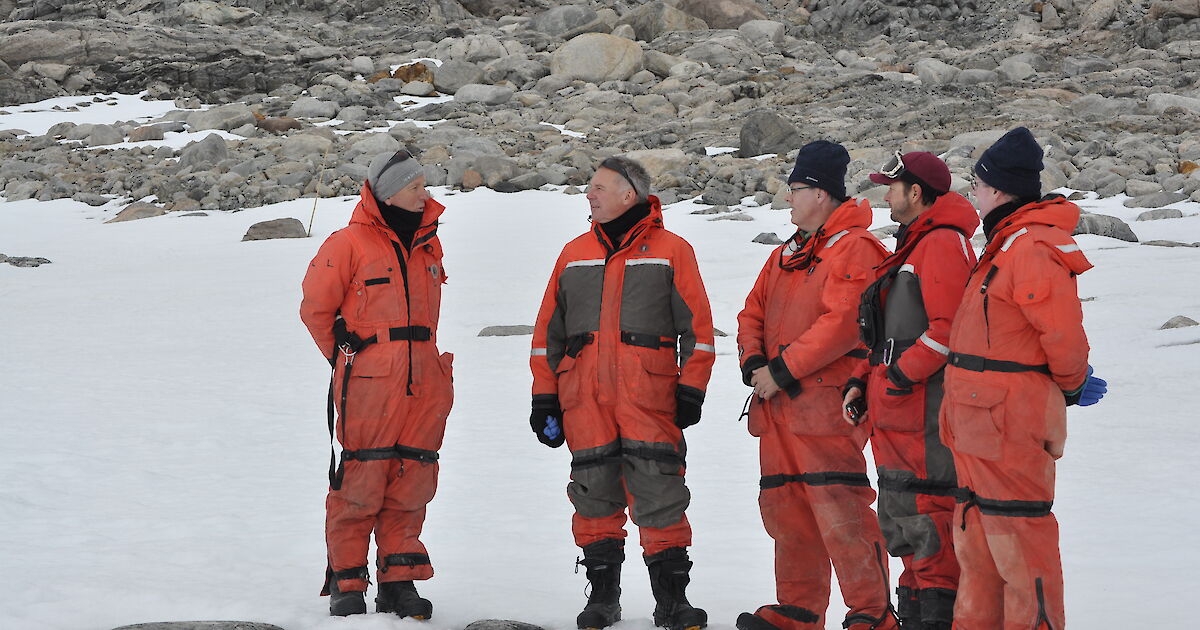
The 7 Pillars of Trump’s Antarctic Influence Strategy: A Closer Look
Antarctica, a continent of pristine ice, scientific endeavor, and growing geopolitical interest, has become a fascinating focal point for global powers. While much of the recent discussion has centered on the Arctic, the Trump administration’s approach to the Southern Hemisphere’s icy frontier deserves a deeper examination. Understanding the potential “Trump’s Antarctic influence strategy” requires dissecting the key tenets that guided his administration’s actions and its forward-looking implications. This post aims to illuminate these foundational elements, offering insights into how the United States’ engagement with Antarctica might evolve.
Pillar 1: Prioritizing National Security in Polar Regions
A cornerstone of any assertive foreign policy is the prioritization of national security. For Antarctica, this translated into viewing the continent not just as a scientific preserve, but as a strategic territory where national interests could be advanced and protected. This perspective, articulated in policy shifts, signaled a departure from a purely scientific or environmental focus, framing Antarctica within a broader geopolitical context. This approach suggests a more active stance in safeguarding U.S. interests and projecting influence in a region increasingly eyed by other global players.
Pillar 2: Enhancing U.S. Presence and Capabilities
Influence is often built on tangible presence and demonstrable capability. The Trump administration recognized this by advocating for increased investment in the infrastructure and logistics necessary to support U.S. operations in Antarctica. This focus on bolstering research stations, icebreakers, and logistical networks aimed to ensure the United States maintained a leading edge in its ability to operate and exert influence on the continent. Such investments are crucial for scientific research, but also for projecting a robust national presence.
Pillar 3: Strategic Alliances and Partnerships
No nation operates in isolation, especially in a complex international framework like the Antarctic Treaty System. The Trump administration’s strategy likely involved leveraging existing alliances and seeking new partnerships to strengthen the U.S. position. This could involve coordinating efforts with like-minded nations on scientific endeavors, resource management, and the enforcement of treaty principles. Building a coalition of support is a powerful way to amplify influence and ensure collective interests are met.
Pillar 4: Economic Opportunity and Resource Potential
While the Antarctic Treaty currently prohibits mineral resource exploitation, the potential for future resource access remains a long-term consideration for many nations. The Trump administration’s approach may have included a strategic outlook that acknowledged Antarctica’s latent economic potential, even if immediate exploitation was off the table. This foresight could involve positioning the U.S. to be a leading voice in any future discussions or frameworks governing resource utilization, ensuring that American interests are at the forefront.
Pillar 5: Science Diplomacy and Technological Advancement
Antarctica serves as a unique natural laboratory for groundbreaking scientific research. The Trump administration’s strategy likely emphasized the role of science diplomacy – using scientific collaboration as a tool to foster international goodwill and advance national interests. By supporting cutting-edge research and technological innovation in Antarctica, the U.S. can solidify its reputation as a leader in polar science, thereby increasing its influence and attractiveness to international partners. This pillar directly links scientific leadership with diplomatic strength.
Pillar 6: Countering Emerging Challenges and Competition
As global competition intensifies, so too does the interest in previously overlooked regions. The Trump administration was likely attuned to the growing presence and ambitions of other nations in Antarctica. Its strategy would have involved identifying and countering potential challenges to U.S. influence and the principles of the Antarctic Treaty. This proactive stance aims to preserve the existing governance framework and prevent the emergence of unilateral actions by other states that could undermine the continent’s peaceful and scientific character.
Pillar 7: A Forward-Looking Vision for Polar Governance
Ultimately, shaping influence requires a clear vision for the future. The Trump administration’s Antarctic strategy was likely informed by a forward-looking perspective on polar governance. This includes anticipating future challenges, such as climate change impacts and potential shifts in the international legal landscape, and developing proactive policy responses. By articulating a comprehensive vision, the U.S. can guide the evolution of Antarctic governance in a direction that aligns with its long-term strategic objectives and the preservation of the continent for peaceful purposes.
Conclusion: Navigating the Future of Antarctic Influence
Understanding the “7 Pillars of Trump’s Antarctic Influence Strategy” provides a framework for analyzing past actions and anticipating future developments. While the specific implementation and emphasis of these pillars may vary, their underlying principles offer crucial insights into how nations can and do exert influence in this unique and vital region. For those invested in the future of Antarctica, from scientists to policymakers, grasping these strategic underpinnings is essential for informed engagement and effective advocacy in the years to come.

Additional Information
It appears there’s a misunderstanding or a projection of potential future policies. As of my last update, there isn’t a publicly defined “7 Pillars of Trump’s Antarctic Influence Strategy.” The search results provided, while relevant to Trump’s approach to polar regions, mostly focus on the Arctic or on potential shifts in U.S. policy, particularly concerning funding and national security.
However, we can analyze the implications and potential directions of a Trump administration’s Antarctic policy based on the provided information and the general trends in his foreign policy. This analysis can be framed as what could constitute an “Antarctic Influence Strategy,” drawing on past actions and stated priorities.
Here’s a detailed breakdown, interpreted through the lens of potential strategies, incorporating the provided search results:
Analyzing a Potential “Trump Antarctic Influence Strategy”: Inferred Pillars and Their Implications
While no explicit “7 Pillars of Trump’s Antarctic Influence Strategy” have been formally declared, we can infer potential strategic directions and their underlying principles based on his administration’s actions, stated policies, and broader foreign policy philosophy. The provided search results offer crucial insights into the potential reorientation of U.S. engagement with the polar regions, including Antarctica.
Here’s an analysis of what could constitute the foundational elements of such a strategy, with a focus on influence:
Pillar 1: Reassertion of U.S. Leadership and Strategic Importance
Analysis: Trump’s foreign policy has consistently emphasized American leadership and a transactional approach to international relations. In the polar regions, this translates to a desire to maintain or re-establish U.S. primacy, not necessarily through multilateral cooperation as traditionally practiced, but through demonstrating strength and strategic intent.
Search Result Connection:
- Result 4: “President Trump’s New Polar Strategy Is the First Step to Defending the…” highlights a proactive, security-focused approach. This suggests a mindset that views the polar regions as arenas where national interests must be actively defended and asserted.
- Result 7: “Trump’s Presidency and the Arctic: Shaping Geopolitics in the Far North…” notes how Denmark’s Minister of Defence acknowledged Trump’s Arctic policy as a significant security challenge, necessitating a strengthened Danish presence. This indicates that Trump’s actions, even if primarily focused on the Arctic, have ripple effects that prompt other nations to re-evaluate their own strategic positioning, a testament to U.S. influence.
Implication for Antarctica: This pillar would likely involve showcasing U.S. capabilities in Antarctic operations, potentially through increased naval presence, logistical support, and scientific expeditions, framed as a demonstration of strength and commitment rather than purely scientific endeavor.
Pillar 2: Strategic Realignment and Geopolitical Competition
Analysis: The changing geopolitical landscape, particularly the growing assertiveness of China and Russia in the Arctic and Antarctic, likely informs a Trump-style strategy. This pillar would focus on countering perceived threats and securing U.S. interests in the face of evolving global power dynamics.
Search Result Connection:
- Result 2: “Trump defunding US out of Antarctica’s great game – Asia Times” and Result 3: “Trump’s $60m Antarctic infrastructure cut is a blow to US influence at …” point to a potential reduction in traditional U.S. engagement, which, paradoxically, can be a strategic move to force a reassessment and reallocate resources towards areas deemed more critical for competition. The mention of China and Russia in Result 3 specifically highlights the competitive aspect.
- Result 5: “Polar Realignment: Trump, Putin, and the Future of Arctic Power…” directly addresses the potential for a shift in the global political order driven by Trump’s actions and his relationship with Russia. While focused on the Arctic, the strategic calculus is transferable to Antarctica.
Implication for Antarctica: This could involve a more targeted approach, prioritizing areas or activities that directly serve U.S. national security or economic interests, potentially in response to the activities of other major powers like China’s burgeoning presence and research stations.
Pillar 3: Resource-Centric and Economic Considerations
Analysis: Trump’s presidency often prioritized economic growth and resource exploitation. While direct resource extraction in Antarctica is governed by the Madrid Protocol, a strategic U.S. approach could involve ensuring access to information about potential future resources and maintaining a dominant role in scientific research that could inform future economic opportunities.
Search Result Connection: While not explicitly stated in the provided results regarding Antarctica’s resources, the broader “America First” economic agenda suggests a focus on securing economic advantages. The cuts to science funding (Results 2 & 3) could be seen through this lens – a re-evaluation of where taxpayer money yields the most strategic or economic return.
Implication for Antarctica: This pillar might involve prioritizing scientific research that has potential future economic applications (e.g., marine resources, rare earth elements, or technologies developed from Antarctic conditions) and ensuring that U.S. scientific dominance provides a foundation for future claims or influence over resource management.
Pillar 4: Streamlining and Modernizing Operations (Potentially through Cuts)
Analysis: Trump’s administration often favored a more streamlined, less bureaucratic approach to government. Funding cuts, as indicated in the results, could be framed as an attempt to eliminate inefficiencies and focus resources on core capabilities.
Search Result Connection:
- Result 2: “Trump defunding US out of Antarctica’s great game – Asia Times” and Result 3: “Trump’s $60m Antarctic infrastructure cut is a blow to US influence at …” are direct evidence of this pillar. The argument might be that by cutting perceived less essential spending, the U.S. can better fund its high-priority Antarctic needs, or perhaps even pressure allies to contribute more.
- Result 6: “National security elites accept Trump is creating a new world order…” suggests a willingness to disrupt existing norms and create new frameworks, which could extend to how operational funding is managed.
Implication for Antarctica: This could lead to a more focused, perhaps even more technologically driven, approach to U.S. Antarctic activities. Instead of broad-based support, investment might be concentrated in cutting-edge research or logistical capabilities that provide a distinct advantage. The risk, however, is alienating allies or reducing overall capacity.
Pillar 5: Diplomatic Leverage and Bilateral Engagements
Analysis: Trump’s diplomacy was often characterized by bilateral deals and personal relationships. In the Antarctic context, this could translate to leveraging U.S. scientific and logistical leadership to foster specific alliances or to exert influence in the Consultative Meetings of the Antarctic Treaty.
Search Result Connection:
- Result 5: “Polar Realignment: Trump, Putin, and the Future of Arctic Power…” suggests a willingness to engage directly with potential rivals, which could also extend to Antarctica.
- Result 1: “Forecasts and Recommendations about the Second Trump … – CSIS” specifically mentions “policy priorities of the incoming Trump administration towards the Arctic and the Antarctic and provides recommendations to achieve these priorities.” This implies a focus on actionable policy and potentially on leveraging relationships.
Implication for Antarctica: The U.S. might use its influence within the Antarctic Treaty System to shape norms and regulations, potentially through direct engagement with key nations or by offering specific logistical or scientific partnerships in exchange for diplomatic concessions or alignment on broader geopolitical issues.
Pillar 6: Technological Advancement and Innovation
Analysis: A strategic approach often involves staying ahead of the curve technologically. For Antarctica, this could mean investing in advanced research platforms, autonomous systems, and sophisticated data analysis to maintain a scientific and operational edge.
Search Result Connection: While not explicitly stated, the concept of “defending” and “reasserting” leadership (Result 4) often relies on technological superiority. The potential cuts could, in theory, be redirected towards more advanced technologies rather than maintaining existing infrastructure.
Implication for Antarctica: This pillar would focus on investing in cutting-edge scientific instruments, advanced icebreakers, and innovative logistical solutions that enhance the U.S.’s ability to operate effectively and conduct groundbreaking research in the challenging Antarctic environment.
Pillar 7: Narrative Control and Information Dominance
Analysis: Trump’s presidency was marked by a strong focus on shaping public perception and controlling the narrative. In Antarctica, this could involve emphasizing U.S. contributions to science and environmental stewardship, while downplaying or reframing any controversial actions.
Search Result Connection: Result 6: “National security elites accept Trump is creating a new world order” hints at a broader strategy of reshaping perceptions and establishing new norms. The “great game” mentioned in Result 2 also implies a contest of narratives and influence.
Implication for Antarctica: The U.S. would likely seek to highlight its long history of scientific exploration, its commitment to the Antarctic Treaty, and its role in conservation efforts. This would be a way to maintain soft power and influence international perceptions of U.S. actions in the region.
Conclusion:
While an explicit “7 Pillars of Trump’s Antarctic Influence Strategy” is not documented, the provided search results allow us to infer a potential strategic framework. Such a strategy would likely be characterized by a reassertion of U.S. leadership, a focus on geopolitical competition, economic considerations, operational streamlining (potentially through cuts), bilateral diplomatic leverage, technological advancement, and narrative control. The key takeaway from the provided results is that a second Trump administration would likely approach polar regions with a renewed, potentially disruptive, focus on national interests, which could reshape the U.S. role in Antarctica significantly. The effectiveness and nature of this influence would depend heavily on the specific policies enacted and the global context at the time.






Leave a Reply